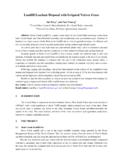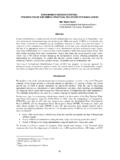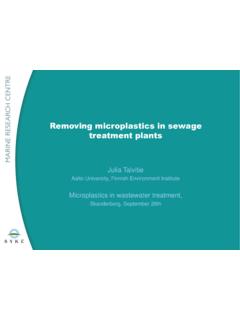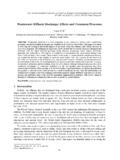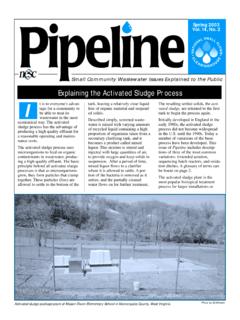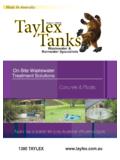Transcription of Vetiver System for Industrial Wastewater Treatment in ...
1 Vetiver System for Industrial Wastewater Treatment in Queensland, Australia Cameron Smeal1, Margo Hackett2, and Paul Truong3. 1. Environmental Manager, GELITA Australia, Queensland, Australia 2. Environmental Officer, Teys Bros., Queensland, Australia 3. Veticon Consulting, Brisbane, Queensland, Australia Abstract: The disposal of Industrial Wastewater in Queensland is subjected to the strict environmental guidelines enforced by the Environmental Protection Authority. The most common method of treating Industrial Wastewater in Queensland is by land irrigation, which is presently based on tropical and subtropical pasture plants. However with limited land area available for irrigation, these plants are not efficient enough to sustainably dispose of all the effluent produced by the industries. Therefore to comply with the new standards, most industries are now under strong pressure to upgrade their Treatment processes.
2 Over the past two years a series of research projects conducted at GELITA Australia gelatine factory in Beaudesert, Queensland and at Teys Bros. abattoir in Beenleigh to determine a viable means to achieve these goals. The Vetiver System has been identified as having the potential to meet all the criteria: Vetiver has the potential of producing up to 132 t/ha/year of dry matter yield as compared to 23 and 20 t/ha/year for Kikuyu and Rhodes grass respectively. With this production Vetiver planting has the potential of exporting up to 1920 kg/ha/year of N. and 198 kg/ha/year of P as compared to 687 of N and 77 kg/ha/year of P for Kikuyu and 399 of N and 26 of P for Rhodes grass respectively. Vetiver growth can respond positively to N supply up to 6000 kg/ha/year and to ensure this extraordinary growth and N uptake, P supply level should be at 250/ha/year.
3 Based on the above results the two companies have developed long term implementation plans for effluent and other solid waste product disposal. Key words: Vetiver , effluent disposal, irrigation, nutrient, fodder Email contact: Cameron Smeal or Paul Truong 1 INTRODUCTION. GELITA owns and operates a plant for the manufacture of gelatine from cattle skin at a site at Sunny Hills via Beaudesert in Queensland Australia. This plant is situated on a property of 170 ha, approximately 75 kilometres from Brisbane. The GELITA operation is a medium sized enterprise employing 70 full time staff and producing 2200 tonnes of gelatine each year for an approximate annual turnover of $AU30 million per year. Raw materials are sourced from meatworks across the country and consist of face pieces and scraps of hide of little other commercial value.
4 The manufacturing process is unique to this country and requires a high through put of water to be effective. GELITA generates approximately ML a day of Wastewater , which is characteristically high in nitrogen and total dissolved salts. TEYS Bros Pty Ltd operates a beef abattoir in Beenleigh, Queensland. effluent generated by the plant is passed through various primary Treatment devices and to irrigate 65ha of Kikuyu grass pasture. The Queensland government has applied strict regulations regarding the disposal of this Wastewater . In order to meet these regulatory requirements and to fulfil expectations of ESD. (Ecologically Sustainable Development), GELITA and Teys Bros. have undertaken a comprehensive research program to develop optimal disposal methodologies. 2 CURRENT CONSTRAINTS. The GELITA factory extracts gelatine from cattle hide using chemical processes involving strong acids, lime and hydroxides.
5 The site consists of 170 hectares of land with 121 hectares licensed by the Environmental Protection Authority (EPA), for disposal of effluent generated in the production of gelatine. The effluent from the processing plant is highly saline (average 6 dS/m), alkaline and has a high organic matter content. This effluent is further processed in a typical series of anaerobic and aerobic digestive processes to lower the nitrate contents to approximately 300 mg/L of nitrogen and 2 mg/L of phosphorus. The property has 13 distinct soil types, which range widely in their properties from Rudosol, Dermosol, Vertosol to Sodosol. Of these soil types only the Rudosol alluviums display acceptable characteristics to deal with the long-term application of effluent . effluent applied to the Sodosol and Vertosol clay soils can result in a surface concentration of salts that affects the root zone and is not considered a long-term sustainable practice.
6 Due to extreme climatic variations over the seven years of operation the planting of pasture and annual crops has not provided a viable operational methodology as concentrations of salts in soil increase proportionately to diminishing rainfall. In order to ensure sustainability of the disposal process, an alternative method was sought that would allow for the flushing of salts through the soil profile whilst stripping the nitrogen from the solution. Such a process would meet the EPA requirements and eliminate a real environmental risk to the operation. TEYS Bros abattoir in Beenleigh, Queensland, which processes in the order of 210 000 cattle per year for both domestic consumption and export. effluent generated by the plant is passed through various primary Treatment devices and a series of ponds prior to on-site irrigation of 65ha Kikuyu grass pasture.
7 Previous investigation has concluded that the current effluent irrigation scheme is unsustainable in the long term. In response to this situation, the management is looking for means of disposing the effluent output more sustainably. 3 LICENSING LIMITS FOR NITROGEN AND PHOSPHORUS. Under Queensland law, the Treatment of Industrial Wastewater is administered by the EPA, which has adopted a computer model - MEDLI (Model for effluent Disposal using Land Irrigation), as a basic tool for Industrial Wastewater management. MEDLI is a Windows based computer model for designing and analysing effluent disposal systems, which use land irrigation, for a wide range of industries such as piggeries, feedlots, abattoirs, sewage Treatment plants, and food processing factories (Truong et al., 2003;. Vieritz et al., 2003). For GELITA, the current licensing limits set out under the EPA permit the irrigation of ML/day of Wastewater with a maximum Nitrogen level of 200 mg/L, total Phosphate at 5mg/L and total dissolved salts of 12 t/ha/annum.
8 4 CURRENT MANAGEMENT PRACTICES. To comply with EPA licensing conditions, the GELITA factory effluent output is currently distributed by spray irrigation from hard hose traveling irrigators across 121 hectares of grassland dominated by Rhodes grass. This is a command and control mode in which compliance is assessed by comparison with of sample data with fixed criterion. The license controls fail to adapt appropriately to extremes of climatic conditions and production variability. Under a strict licensing interpretation, the current practice is not adequate in providing a long-term sustainable Treatment solution. At Teys Bros a total area of 65 ha is available for irrigation, but after allowing for buffer perimeter, currently only are can be used for irrigation. Currently effluent is either spray or surface irrigated onto Kikuyu pasture at various sites around the property.
9 The pasture is not harvested and the application uniformity is quite poor. Current MEDLI modelling predicted that only 204 ML/year could be disposed off if Kikuyu pastures were used. This would leave a surplus effluent volume of 347 ML/year to be treated by other means. 5 SEARCHING FOR A MORE INNOVATIVE AND NATURAL SOLUTION. For GELITA, alternative solutions such as chemical Treatment plant and transportation to sewage Treatment plant were considered but both of which are impractical and most importantly very costly to build and to operate. Therefore a more innovative and natural solution was needed. Tree planting was one of the earlier options considered, it has been trialed for several years but has not provided an effective solution to the problems faced by the company. To date no data is available for comparison of the effectiveness of the two eucalypt species trialed for N uptake as opposed to that of traditional pasture regimes.
10 Preliminary findings have established that an estimated t/ha/year dry matter yield of pasture will result in a N export of 458 kg/ha/year from between tree rows if an assumed N level of occurs. No further results are expected from these trials for some time. This is not an outcome that meets the company objectives, as the EPA requires an updated farm management program to be submitted by the end of September 2003. Due to the limit of the land area, TEYS Bros abattoir will pipe excess effluent output to the Logan Shire Council for Treatment . The cost of treating this effluent is based on both quantity and quality of the effluent . Therefore any means, which can lower the volume and/or the nutrient loading of the effluent will reduce the costs of Treatment to the company. Application of the Vetiver System (VS) for Wastewater Treatment is a new and innovative phytoremedial technology developed by the Department of Natural Resources and Mines in Queensland, (Truong and Hart, 2001).



